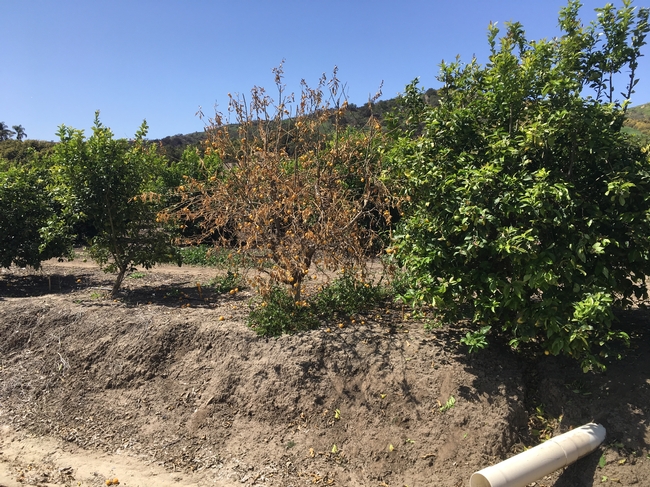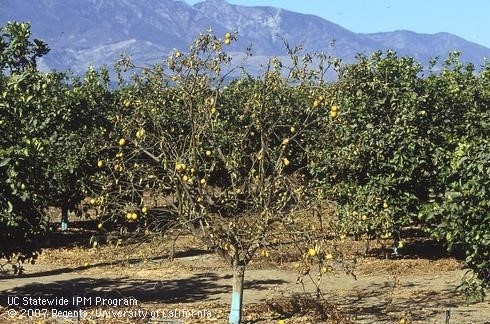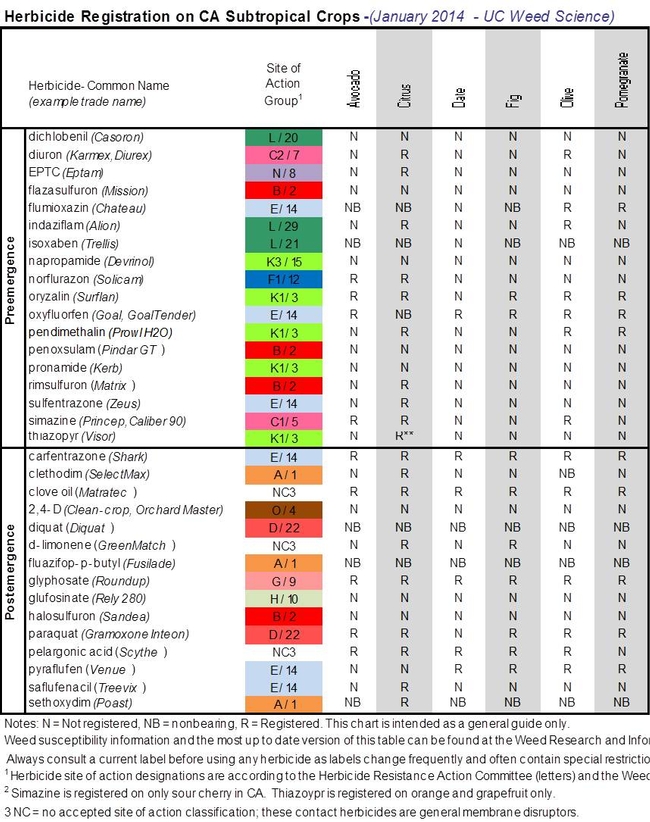
Posts Tagged: dry root rot
Citrus Dry Root Rot
Nick Sakovich, Emeritus Farm Advisor
Dry Root Rot has menaced growers in Ventura County for many years. In the ‘50's and ‘60's it seemed most prevalent on older orange trees. A few years after the wet winter of 1968-69, dry root rot became an increasing problem among citrus trees of all ages. At that time, most of the damaged trees were on sweet rootstock (susceptible to Phytophthora), and growing in fine-textured soils or soils with poor drainage. A few years after another wet winter/spring (of 1983), dry root rot again reared its ugly head, but this time predominately on young lemons.
The disease is caused by the fungus, Fusarium solani. This fungus is most likely present in all citrus soils in California. It is a weak pathogen in that by itself it will not attack a healthy tree. However, experiments conducted in the early 1980's by Dr. Gary Bender, showed that when seedlings were girdled, root invasion occurred. In the field, the fungus can infect trees once gophers have girdled the roots or crown. A Phytophthora infection will also predispose trees to Fusarium, as will asphyxiation. Therefore, the mere presence of the fungus in the orchard soil will not lead to the disease.
Description
Fusarium is a soil borne fungus that invades the root system. Once infected, the entire root will turn reddish-purple to grayish-black. This is in contrast to a Phytophthora infection which, in many cases, will attack only the feeder roots, but when larger roots are infected, only the inner bark is decayed and it does not discolor the wood. In addition, when observing the cross section of a dry root rot infected trunk, a grayishbrown discoloration in the wood tissue can be observed.
Dry root rot is a root disease, but symptoms of the root decline are seen above ground. They are similar to any of the root and crown disorders such as Phytophthora root rot, oak root rot fungus (Armillaria) and gophers. The trees lack vigor, leaves begin to turn yellow and eventually drop (especially in hot weather) causing twig dieback. Finally, the foliage will become so sparse that one will be able to see through the canopy of the tree. A period of two to three years may pass from the time of invasion until noticeable wilt. Many times, the tree will collapse in the summer, after a period of prolonged heat. In the case of dry root rot, the collapse is so rapid that the tree dies with all the leaves still on the tree. When looking for symptoms of dry root rot, keep an eye out for symptoms of other maladies as well — Phytophthora, oak root rot fungus and gophers being the most prevalent.
As mentioned previously, in order for Fusarium to infect a tree, there must be a predisposing factor such as girdling from gopher feeding. However, since many trees collapse from dry root rot without any apparent predisposing factor, there are obviously other factors which we have yet to identify. Therefore, in 1998, a grower survey was developed, along with intensive soil and leaf sampling, to attempt to identify as many new predisposing factors as possible. They might be elements in the soil, either deficiencies or excesses, or specific cultural practices such as irrigation patterns or fertilizer practices. Twenty orchards were identified from which 20 soil and 20 leaf samples were taken in diseased areas and another 20 soil and 20 leaf samples were taken from adjacent healthy areas. The owners or managers of the properties were given a questionnaire to complete regarding a variety of cultural operations. The objective was to identify those factors that would correlate well to trees becoming infected with dry root rot.
Survey Results
Soil analysis - The following laboratory procedures were conducted to see if there was any correlation between the disease and either deficiencies or toxicities of these elements or
conditions: sodium, boron, salt level, pH and soil type (sand, loam, clay). For these elements or conditions, no correlation was found. It would appear that for our sampling sites, these conditions, whether favorable or not (toxic or deficient), did not play a major role in predisposing the tree to dry root rot.
Leaf analysis - The following elements were analyzed for their concentration within the leaf: nitrogen, potassium, phosphate, manganese, magnesium and zinc. Of these, three correlations were found. Zinc and manganese levels were substantially higher in diseased trees. The third correlation showed a potassium deficiency in diseased trees. However, we do not believe that dry root rot is caused by elevated levels of zinc or manganese, or by potassium deficiency, but rather are a result of the disease. Unfortunately, it seems that we have still not identified any elements in leaf analysis that truly correlates and points to a predisposing factor for disease development.
Grower survey - The grower survey included questions on planting site (location, wind, previous crop, fumigation etc.), trees (source, type, rootstock, etc.), and cultural practices (irrigation, fertilization, gophers, history of Phytophthora, water quality, etc). Through statistical analysis it was found that the healthy and diseased sites were significantly different with reference to three conditions or situations: 1.) The presence of Phytophthora in an orchard will increase the chance of those trees succumbing to dry root rot. 2.) Orchards that have been fumigated have a less likely chance of succumbing to dry root rot. 3.) Balled vs. Container Plants -- growers were asked if their trees were balled or container
grown nursery plants. Healthy sites were significantly more likely to have been planted with balled trees (73% vs 33%). The results of this analysis were not strong, but rather they
suggest that there is a relationship between the disease and the type of tree planted - balled or container grown - and suggesting in favor of a balled tree for a healthy orchard.
Control Measures – What Works and What Does Not
Early experiments conducted by Menge, Ohr and Sakovich showed that the following circumstances or operations do not influence the incidence of this disease: fungicidal treatments, wounding the tap root at time of planting, sandy versus clay textured soils, spring versus fall planting and soil mounding.
- In choosing your nursery tree, the choice of rootstock is not important in that, as far as we know, all rootstocks are susceptible to this disease. However, since Phytophthora is a major component in dry root rot development, choosing a rootstock like sweet orange would certainly put those trees in a high risk category. We recommend that growers use Phytophthora resistant rootstocks like C35 or Citrumelo.
- According to the survey, it would be advantageous to fumigate before planting. Methyl bromide, although expensive, is the best fumigant as it is a complete biocide. If one chooses not to fumigate, the alternative would be a number of fungicide/nematicide applications to the newly planted trees. Generally speaking, this may work well with trees planted on a rootstock like Citrumelo or C35.
Phytophthora. Publications written in the 1970's, and again noted by our survey, showed that Phytophthora is a major culprit in the dry root rot complex. To control dry root rot, it is essential that the Phytophthora, when present, be controlled. This can be accomplished by fungicidal treatments, and by the proper application and timing of irrigation water. Overwatering creates a favorable environment for the multiplication of the Phytophthora fungus.
Gophers. It is well known that gopher damage provides entry points for Fusarium. Controlling gophers is an important factor in reducing the potential of infection by Fusarium.
Control
We presently have no direct control for dry root rot. To control the disease, we must control the predisposing factors such as gophers, Phytophthora, poor drainage and over-watering. If the predisposing factor(s) cannot be identified for a given diseased orchard, it will indeed be difficult to control the disease. Two things are certain though: 1.) There are no chemicals to date which will control this disease; and 2.) Presently, there are no rootstocks resistant to the disease.
Hear the latest on DRR with Akif Eskalen – a Webinar, July 24
https://ucanr.edu/blogs/blogcore/postdetail.cfm?postnum=30658

citrus dry root rot
Here Comes Citrus Dry Root Rot
Citrus Dry Root Rot
This impressive tree collapse is most noticeable after rainy season and the first heat waves after the rains
Citrus Dry Root Rot (July 24, 2019 from 3-4 pm)
Dr. Akif Eskalen, Plant Pathologist, UC Cooperative Extension Specialist, will discuss the symptoms, biology and management of citrus dry root rot. More information to come. One DPR CE unit (other) and one CCA CE unit (IPM) are pending.
Register in advance for the webinars by clicking on the event links above.
And if you missed it
Recording of the Management of Weeds in Citrus Orchards webinar is now available on YouTube - https://youtu.be/DU5bpRnq8DI
Dr. Travis Bean, assistant weed science specialist in UCCE, discussed the importance of weed management in citrus, tree age and variety considerations, scouting and weed identification, cultural and mechanical practices, and pre- and post-emergence herbicides.
Upcoming topics:
- Spray technology for tree crops (August)
- California Red Scale (September)
- Avocado diseases II. (October)
- Use of Plant Growth Regulators in Avocado (December)
Register in advance for the webinars by clicking on the event links above.
Are there Continuing Education units?
When the subject discusses pest or disease management, continuing education units will be requested from DPR (1 unit per session). Participants will pre-register, participate in the webinar and be awarded the unit. The sessions will be recorded and hosted on this web site for future study. However, continuing education units will be awarded only to the participants who attend the live version of the webinar.
Who is involved?
This webinar series is brought to you by Ben Faber (UC ANR Ventura Advisor) and Dr. Beth Grafton-Cardwell (Depart of Entomology UC Riverside Extension Specialist) with the technical support of Petr Kosina (UC IPM Contect Development Supervisor) and Cheryl Reynolds (UC IPM Interactive Learning Developer).
It's Dry Root Rot Time
Even though it's been a mild winter; other than fire, rain and some cool nights, we did have a few days of hot weather, which is just what sets off citrus dry root rot. It pops up after the first hot weather of the spring, and there it was driving down the road. There's nothing that can be done with this tree. Tree removal and replacement is the answer. Prevention is the solution. We know that Fusarium fungus is usually associated with the collapse, but wounding is the key. Mechanical injury from weed whips, discs, gophers, voles, rabbits. Wounding from salt damage might do it too.
Dry root rot, a disease caused by the soil fungus Fusarium solani, has a long history of hindering production of citrus in California. Fusarium solani is a weak pathogen that infects only when there is some kind of stress in citrus tree. However, presence in almost all citrus orchards everywhere in the world including California, enhance its quick exploitation of such stresses. Some of the factors that are possible stress include invasion by other pathogens, such as Phytophthora and Citrus Tristeza Virus (CTV). Other stresses are wounding by gophers/rodents or insects, girdling, asphyxiation especially drowning the tree with too much water, soil nutrient content and fertilization, irrigation, and other cultural practices in the orchard. The pathogen is an opportunist on citrus. With the stress, Fusarium solani begins infection by colonizing the cortical tissue of feeder roots, advances into the lower tap root and/or scaffold root, and move up through the bud union into the center of the trunk. Studies over the years have shown that many rootstocks are susceptible and old trees as well as young twigs are not spared of the disease.
http://ipm.ucanr.edu/PMG/r107100211.html
//ucanr.edu/blogs/blogcore/postdetail.cfm?postnum=17821
Photo: collapsed tree near and older one on the right, but also near a younger one that probably was a replacement for one that had collapsed several years prior

dry root rot time
Citrus Sudden Collapse
This has been a hot time. Look for irrigation problems, but also look for other weather related problems. This is possibly the most shocking.
If you see your citrus tree suddenly collapse. It happens on a weekend or in a few days, and it has suddenly turned hot with a Santa Ana or Sundowner, it is quite likely "Dry Root Rot". This is a situation where the water conducting tissues, the xylem, have been clogged by fungi and when a sudden demand for water comes from the weather, the tree collapses because it can not support the movement of enough water to satisfy that demand. It is more common along the coast than the Valleyk, but it does occur there, as well.
It starts with some type of wound to the crown roots or stem - gophers or field mice nibbling away at the roots or crown. Or damage from weed whipping or some sort of mechanical damage. This allows entry of the Fusarium fungus that causes the xylem clogging. You can usually see the damaged tissue just below the bark, near the base of the tree. The damage has usually occurred several years prior and takes awhile for the fungus to do its clogging. There's no know cure for this situation. Cut the tree out. It's not particularly contagious as far as we know. The fungus is cosmopolitan, meaning it is found in most orchards, and it just waiting for a wound to invade. You can replant into the orchard, but just avoid causing wounding.
Dry root rot affects all citrus species and varieties.
http://ipm.ucanr.edu/PMG/r107100211.html
Photos:
Collapsed canopy, grapefruit
Dead tissue below the bark

dry root rot grapefruit canopy

dry root rot tissue
Citrus Dry Root Rot
Dry Root Rot is a pretty fantastic disease symptom that is usually seen in lemon, but can be seen in orange, as well.
Craig Kallsen, UCCE Citrus Advisor in Kern Co. comments on a disease sample:
I have seen a lot of dry root rot over the years. It usually is something that damages or weakens the root system which allows a Fusarium species to colonize the rootstock. It is very common in older lemon groves that froze at some point in their past. Also common in groves that suffered a lot of gopher damage or where the wraps got too hot in the sun burning the bark and cambium. I have also seen it in cases of fertilizer or other soil-applied chemical burn. I have no doubt that graft incompatibility could do it too.
Akif Eskalen, UCCE Plant Pathology Specialist chimes in on a disease sample submitted:
As you can see from the attached picture there is a weird callus formation and symptoms of incompatibility at the graft union which I think is the primary cause of decline. We didn't observe any discoloration in the scion, however rootstock was completely discolored where we isolated Fusarium solani the causal fungus of Dry Root Rot. Dry root rot caused by either Fusarium solani and/or Fusarium spp. When there is a disconnection at the graft union, the phloem can not transfer enough carbohydrate to the rootstock to feed feeder roots. Fusarium fungal species are present in the soil and they can attack and easily colonize on starch depleted roots and cause DRR.
We still don't know what is causing the graft incompatibility on these plants. That needs to be investigated.
It's still not clear how and why citrus becomes affected.

dry root rot



